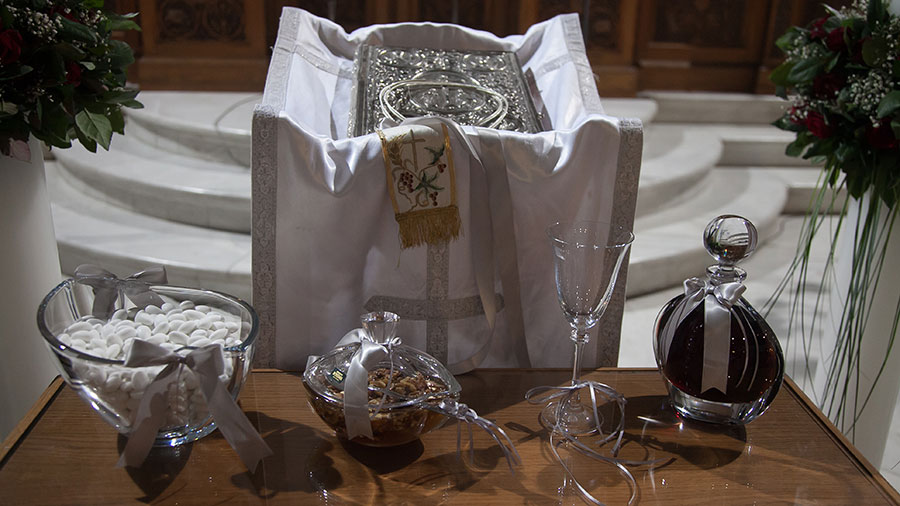Cretan Weddings
Cretan weddings usually follow certain customs. Some of the customs have changed as young generations follow modern weddings some traditions remain. Rituals and customs also vary from town to town and village to village throughout Crete.
The Wedding Bed Ceremony – Known as “To Krevati” (the bed)
A night or two before a wedding takes place a Bed Ceremony is held at the couple’s new home. Family and friends gather while the marital bed is made up by young unmarried girls. Friends and relatives will often jokingly pull the sheets off the bed so that the girls have to re make it numerous times.
When the adults decide that the bed is made to their satisfaction (when the joke is over!) the sheets are then adorned with sugared almonds and flowers petals. Following this a baby or young child is rolled on to the bed for luck and to signal the couple’s future fertility, then the guests throw money on to the bed of the couple.
The Greek Orthodox Church Wedding Ceremony
In the Orthodox Church ceremony the groom arrives at the church with his best man (koumbaros) and family and awaits his bride in front of the church. He holds the brides’ bouquet (flowers as usual but also myrtle the sacred plant of Venus the Goddess of love) which he presents to her as she arrives and they walk into the church together.
Soon after the start of the ceremony the priest blesses the rings and places them on their right hands.
Wedding crowns (stefana) which are joined by a ribbon are placed on the Bride and Groom by the best man, who then stands behind the couple and interchanges the crowns three times as a witness the sealing of the union.
The couple also both drink from a goblet of wine, the ‘Common Cup’.
The wedding ends with the Ceremonial Walk. The priest, bride, groom and koumbaros join hands and walk round in a circle three times. These are the couple’s first steps together as a married couple. As they start the Ceremonial Walk the guests shower rice over them.
The ceremony lasts about 45 minutes and at the end guests file past the bride and groom in church to congratulate them. The parents and best man stand alongside them and often one of them will be holding a tray ‘diskos’ to collect the guests’ wedding present, an envelope of cash ‘fakelaki’.
The Reception
The wedding reception is usually held in the evening, and immediately after the late afternoon/ evening wedding service. Live Cretan (and Greek) music, along with a feast of local food and wine.
Custom dictates that the bride will dance for much of the evening and traditionally the guests take turns to dance with her, starting with the groom, then the best man and his family.
Guests numbering 1000 or more are not unusual as the extended families and friends of both the bride and groom are usually invited as well as the best man’s family and friends, and sometimes even all the villagers too.
The best man is the guest of honor and is just as important as the Bride & Groom.
The weddings of Crete involve whole villages and last many hours …The Best man -woman-invites many of his or her own family and friends. The large number of wedding guests can be seen to date back to when whole villages and communities took part in local weddings in the village church and square, and the custom of inviting most of the village and their families remains among farming communities.
More ‘exclusive’ weddings among young professionals tend to be held in expensive restaurants or hotels but many of the traditions are still followed.
Others hold ‘closed’ weddings meaning that they will limit the number of guests and invite only close relatives and friends.
The guests say to the couple after the wedding ceremony is over Na Zisete (long life to you) to the Bride and Groom, na zisoun (long life to them) to the head members of the bride and groom’s families.
They may reply with “sta dika sas” – literally meaning ‘to yours’, i.e. here’s to your wedding.
If you are married with children the reply will be ‘ston paidion sas’ – to your children’s (wedding)!
Glossary
o gamos – the wedding
h nifi – the bride
o gambros – the groom
koumbaros / koumbara – best man / best woman. The wife of the best man is always
called the best woman – and vice versa.
To Krevati – The bed ( Wedding Bed Ceremony)
to trapezi – the reception (literally meaning ‘the table’)
koufeta – sugared almonds
Source: livingincrete.net






